Tropic movements in plants are the types of paratonic or induced movements. Paratonic movements include both tropic and nastic movements. In this module, we will only discuss the tropic movements in plants.
Various external stimuli or environmental factors like light, gravity, water, temperature, and other factors influence tropic movement. The phenomenon of tropic movements in plants is popularly known as tropism.
Tropism merely refers to the active movement of the plant’s specific parts in response to some physical and chemical factors in order to achieve different cellular growth and development.
The six common tropisms based on external stimuli are phototropism, geotropism, hydrotropism, thermotropism, thigmotropism, and chemotropism. This post describes the definition, key points and different types of tropisms in plants.
Content: Tropic Movements in Plants
Definition of Tropic Movement in Plants
Tropic movements in plants refer to the mechanism through which the different parts of plants show the movement of curvature in response to external stimuli. Plants are sessile organisms. Although, they display the movement of curvature or bend to perform various cellular tasks.
Different parts of plants show different curvature or bending movements relative to the changes in environmental factors. Tropic movement is characterized by more growth on one side and less growth on the other side of the plant’s different parts on the exposure of external stimuli.
Key Points
- Tropical movements in plants are irreversible growth movements.
- It is a form of directional movement, not diffusible.
- The direction of external stimuli influences the orientation of the responding plant organ.
- As every action has an equal and opposite reaction, plants specifically respond to the various external stimuli. Thus, stimulus and response have a direct relationship.
- Plants can respond positively or negatively to different physical and chemical stimuli.
- Unlike nastic movements, tropic movements are comparatively slow.
- The whole plant cannot show tropism, i.e. it is only limited to specific parts of the plant.
- The plant’s organs like roots and stems with radial symmetry show tropism.
- A positive response is towards the stimulus, whereas a negative response is away from the stimulus.
- The active movement of the root or shoot system in response to specific stimuli establishes tropism.
- Tropic responses result from differential growth.
- The coordination between the plant’s responses and various external stimuli is through the plant’s hormones. Hormones coordinate the movement of plants in response to multiple stimuli by the given two ways.
- It affects plant growth by giving motility to the plant’s specific part.
- Plant hormones affect the plant cell’s shape by altering water concentration, thereby causing cell shrinking and swelling.
Video: Tropic Movements in Plants
What is Tropism?
Due to the plant’s sessile nature, they cannot move from one place to the other, unlike humans, animals, birds etc. However, they tend to show different growth responses to cope with copious environmental changes in order to compensate for their sessile nature. Different cellular growth and development in response to external stimuli like light, water, temperature etc., is the characteristic feature of tropism.
In tropisms, environmental signals or stimuli orient the direction of a plant’s growth. Tactic movement in microorganisms is similar to the tropism in plants, where they also respond to external stimuli. The tropism mechanism primarily includes the three consecutive stages.
- Firstly, plants sense the type of stimulus and react accordingly.
- Then, signal transduction occurs in plants, which is the mechanism of converting the external stimulus into the source of information to carry out different cellular functions like cell growth and metabolism.
- Later, the information is interpreted in the growing zones of roots and stems, resulting in the directional growth response.
Types and Examples of Tropic Movements in Plants
Plants show six forms of tropisms based on the different external stimuli. We will discuss each type, along with diagrams and examples.
Phototropism
It refers to plant growth in response to the light stimulus. This movement stimulates the auxin hormone that elongates the cells on the opposite side from the light. It is also called heliotropism.
The shoot system (including stems and leaves) grows towards the light’s direction or shows positive phototropism. They rearrange their chloroplasts to maximize photosynthesis and plant growth. Roots grow away from the source of light or show negative phototropism.
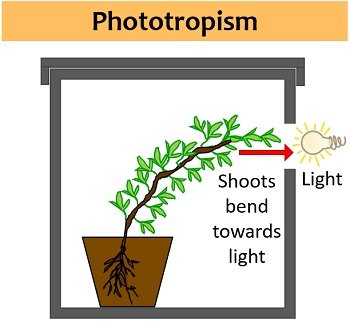
Experiment to demonstrate phototropism:
- Take a potted seedling.
- Place the pot vertically inside a heliotropic chamber.
- Light passes from the hole on one side of the chamber.
- Later, you can notice that the shoot system displays the movement of curvature or bends toward the light source.
Geotropism
The growth of plants occurs in response to the gravitational force. Gravity can be artificial or natural. The shoot tip grows upwards against the gravitational pull or shows negative geotropism. The root tip extends downward, i.e. similar to the direction of gravity, and exhibits positive geotropism.
Thus, roots grow towards the centre of the earth. Plants perceive gravity when the starch granules within the root cells fall towards the bottom of the cell. Later, the cell membrane receives a signal, thereby translating the signal into growth responses.
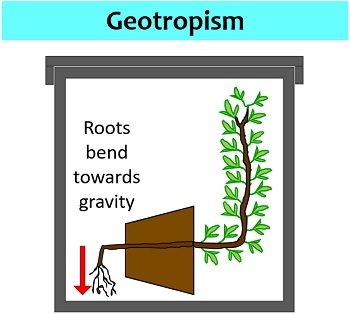
Experiment to demonstrate geotropism:
- Take a potted seedling.
- Place the pot horizontally in a wooden chamber.
- Then, you can observe upward growth of the stem and downward growth of the root.
Therefore, roots will show the movement of curvature by bending towards the direction similar to the gravitational pull.
Hydrotropism
It refers to the growth of plants in response to the water stimulus. Roots show positive hydrotropism, i.e. they show the movement of curvature towards the water. Stems generally display indifferent or negative hydrotropism. In varying concentrations of water, roots respond differently.
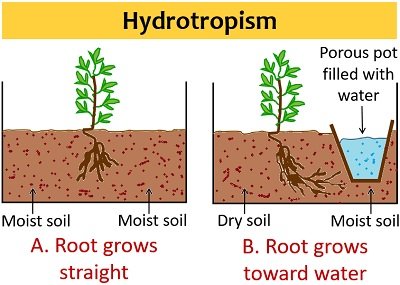
You can see in the above diagram that roots appear straight in the moist soil. But, roots exhibit hydrotropic curvature from the dry soil to the damp soil. The root cap senses the water signal and passes it to the elongated portion of the root.
Thigmotropism
It is also called haptotropism. Here, the growth of the plant occurs in response to the touch or contact stimulus. Unilateral growth inhibition facilitates thigmotropism. Shoots have a positive touch response.
Oppositely, roots show negative thigmotropism or grow away from the support surface. Thigmotropism is marked by the higher growth rate in cells not touching the support surface than cells touching it.
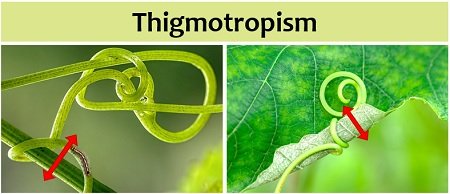
The thigmotropism mechanism results in the opening, closing and twisting of petals and leaves in some plants. Tendrils and twiners show thigmotropism. Differential and rapid contact coiling are the two common forms of thigmotropism.
Specialized epidermal cells bring differential growth. In contrast, rapid contact coiling is the instant response like folding of leaves and stems.
Thermotropism
The growth of plants occurs in response to the temperature stimulus. Plants show positive thermotropism when they grow towards the source of heat. Oppositely, plants show negative thermotropism when they grow away from the heat source.
Philippe Van Tieghem coined the term thermotropism. The curling of Rhododendron leaves under cold temperatures is an example of negative thermotropism. The growth of sunflower plants is an example of positive thermotropism.
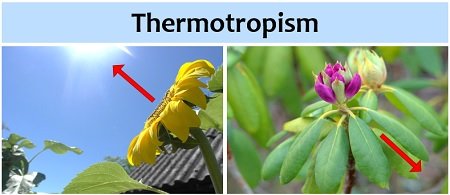
Chemotropism
It refers to the growth of plants in response to some chemicals. Positive phototropism occurs when the plant or a part of the plant responds to the chemical stimuli. In contrast, negative phototropism occurs when a part of the plant grows away from specific chemicals. Roots that grow away from the harmful acids exhibit negative chemotropism.
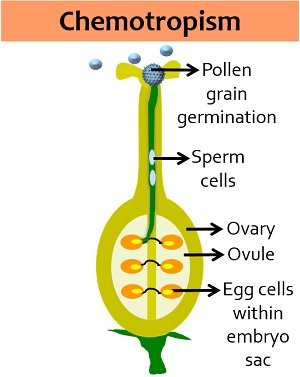
Examples of positive chemotropism include the following:
- Expansion of pollen tube towards the ovary after absorbing calcium and borate from the style.
- Closure of Nepenthes flower’s lid due to the nitrogenous food.
- Conversion of flower to fruit.
- Roots grow towards the essential minerals in the soil.
Based on the direction, tropic movements are categorized mainly into three types. Orthotropic movement in plants occurs toward the external stimulus. Plagiotropic movements in plants occur obliquely in the stimulus direction. Diatropic movements in plants occur vertically in the direction of the stimulus.
Conclusion
Thus, we can conclude that the entire body of plants cannot move. However, parts like roots and stems tend to show tropic movements by sensing the directions of environmental signals like light, temperature, gravity etc. After sensing environmental stimulus, they orient themselves toward or away from the direction of the stimulus.